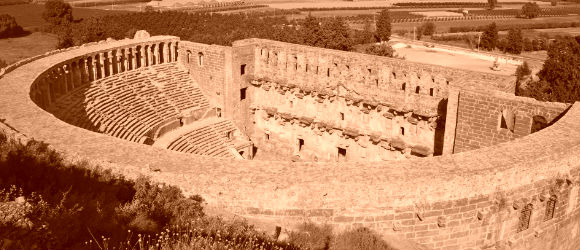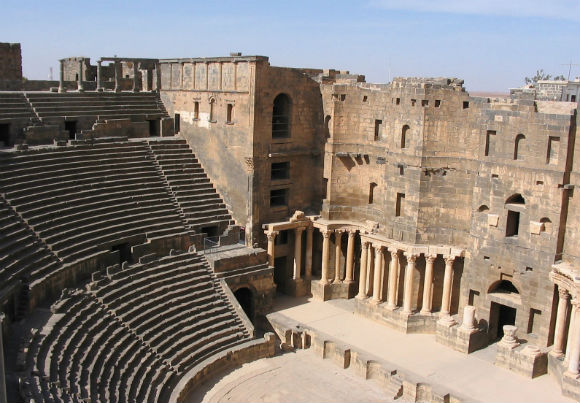Aspendos was an ancient Greco-Roman city in Antalya province of Turkey. It is located 7 kilometres (4.3 mi) northeast of central Serik.
Aspendos was an ancient city in Pamphylia, Asia Minor, located about 40 km east of the modern city of Antalya, Turkey. It was situated on the Eurymedon River about 16 km inland from the Mediterranean Sea; it shared a border with, and was hostile to, Side. According to later tradition, the (originally non-Greek) city was founded around 1000 BC by Greeks who may have come from Argos. The wide range of its coinage throughout the ancient world indicates that, in the 5th century BC, Aspendos had become the most important city in Pamphylia. At that time the Eurymedon River was navigable as far as Aspendos, and the city derived great wealth from a trade in salt, oil, and wool.
Aspendos did not play an important role in antiquity as a political force. Its political history during the colonization period corresponded to the currents of the Pamphylian region. Within this trend, after the colonial period, it remained for a time under Lycian hegemony. In 546 B.C. it came under Persian domination. The face that the city continued to mint coins in its own name, however, indicates that it had a great deal of freedom even under the Persians.
In 467 B.C. the statesman and military commander Cimon, and his fleet of 200 ships, destroyed the Persian navy based at the mouth of the river Eurymedon in a surprise attack. In order to crush to Persian land forces, he tricked the Persians by sending his best fighters to shore wearing the garments of the hostages he had seized earlier. When they saw these men, the Persians thought that they were compatriots freed by the enemy and arranged festivities in celebration. Taking advantage of this, Cimon landed and annihilated the Persians. Aspendos then became a member of the Attic-Delos Maritime league.
The Persians captured the city again in 411 B.C. and used it as a base. In 389 B.C. the commander of Athens, in an effort to regain some of the prestige that city had lost in the Peloponnesian Wars, anchored off the coast of Aspendos in an effort to secure its surrender. Hoping to avoid a new war, the people of Aspendos collected money among themselves and gave it to the commander, entreating him to retreat without causing any damage. Even though he took the money, he had his men trample all the crops in the fields. Enraged, the Aspendians stabbed and killed the Athenian commander in his tent.
When Alexander the Great marched into Aspendos in 333 B.C. after capturing Perge, the citizens sent envoys to him to request that he would not establish that he be given the taxes and horses that they had formerly paid as tribute to the Persian king. After reaching this agreement. Alexander went to Side, leaving a garrison there on the city’s surrender. Going back through Sillyon, he learned that the Aspendians had failed to ratify the agreement their envoys had proposed and were preparing to defend themselves. Alexander marched to the city immediately. When they saw Alexander returning with his troops, the Aspendians, who had retreated to their acropolis, again sent envoys to sue for peace. This time, however, they had to agree to very harsh terms; a Macedonian garrison would remain in the city and 100 gold talents as well as 4.000 horses would be given in tax annually.
In 190 BC the city surrendered to the Romans, who later pillaged it of its artistic treasures. Toward the end of the Roman period the city began a decline that continued throughout Byzantine times.
Aspendos,



there is a day trip were u see perge, aspendos and waterfalls just were sensible footwear.
Aspendos was amazing, it was incredible to be inside the theater and think of all the history that had taken place there. Not impressed with the gladiator available for pictures but otherwise we enjoyed our visit very much!
This is advertised as the best preserved ancient theater in Turkey and indeed it is in much better shape than any other we have visited, and we've seen quite a few. Don't miss the other buildings on the site, notably the Basilica.
Amazing theatre, steep climb to the top, but amazing views from there! Our guide told us the theatre is still used now in the summer time!
This is a-must-to see when you are in Turkey and also have interests for amphitheatre from the antiquity.The best preserved theater of the antique world I have seen.The acoustic of the theater is so excellent ,that a ping pong ball dropped near the stage building can easily be heard at the top row of the seats.Lately many musikal and theatrical…
The amphitheatre is monumental and the surrounding ruins fabulous; a must visit when visiting Antalya region of Turkey. Many excursions available to this site. A note of advise: if going high season take a hat, sunglasses, water and a lot of sunscreen as there is no shelter as outdoors.
The beautifully preserved theatre of Aspendos is well and truly tremendous. Thirty-five percent of this amphitheatre has been restored and the remainder is authentic. When it was built (161AD) it could seat 15,000. Aspendos was a major trading city in its day and was located on the famous Silk Road from Beijing to Rome. Be sure to walk up the…
This site is simply magnificant. Drive there yourself if you can and take the walk up the back of the theatre to look domn…gobsmacking; then walk over the other ruins at the top. Pinch yourself to realise you have seen one hell of a theatre.
Fantastic sets and acoustics always make this a memorable trip. This time we saw Prince Igor. We will go back in September for some more. Just wish it was easier to book tickets!
This is fantastic how they have renovated this and do lots of shows here throughout the summer as well.Great to explore and gets your heart pumping climbing the steps to the top.Take your camera, some great shots from the top,and the kids will love it.Could hear my wife in the theatre at the bottom when I was at the top.Better…